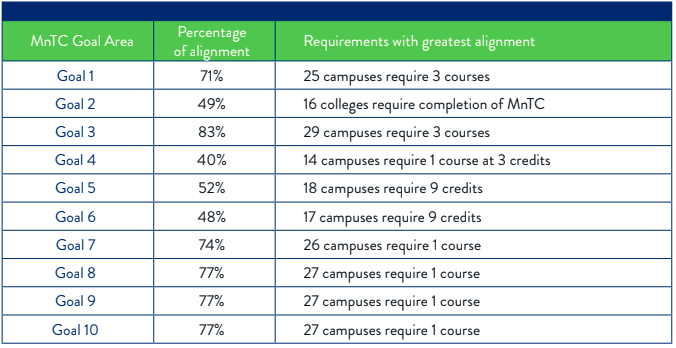Community and Technical College students utilize the transfer process for a variety of reasons, whether as a cost savings approach on their way to a baccalaureate degree, to pursue an education that is closer to home, near employment opportunities, or because of the sense of community have found at their chosen institution. When transfer works, it is a gateway to a quality education, completion of a degree and future success. However, when it fails, it becomes a burdensome barrier often resulting in unnecessary and avoidable debt, loss of already attained course credits, and ultimately the waste of precious time and energy.
When Minnesota State was formed in 1995 one of the primary reasons was to improve the transfer of credits across public post-secondary colleges and universities. It has been over 25 years but major barriers still exist across the Minnesota State system and further action is needed to improve transfer.

MnTC Alignment Across Community and Technical Colleges
Minnesota Transfer Curriculum Barriers
The Minnesota Transfer Curriculum (MnTC) is the general education component of degrees at Minnesota State colleges and universities. In its current form it requires students to complete 40 credits of lower division general education course across 10 different goal areas. It was designed in the mid 1990's to make transfer across Minnesota's postsecondary institutions easier. MnTC however contains inconsistencies that, while apparently small, can balloon into costly and time-consuming barriers for students who transfer between two-year institutions, and create even larger barriers when those students attempt to transfer to a four-year university later.
Across all ten MnTC goal areas, there exists significant variation between institutions in course and credit requirements. The lack of consistency both in the requirements and in the communication of those requirements can force students to repeat courses, slowing their progress towards graduation and costing them precious financial aid eligibility.
Along with the issues of alignment, MnTC has not undergone a significant review or changes in decades. Other states require less credits in their general education curriculum (State University of New York requires 30 credits) or have a reduced number of goal areas students need to complete. It is time for Minnesota to make sure our lower division requirements are preparing students for life, work, and citizenship in the 21st century.
Solutions:
- Require all colleges and universities to have alignment in the number of credits or courses required under each goal area of MnTC.
- Review MnTC to revise and reduce the number of goal areas and credits required.
Common Course Numbering
Inconsistent course numbering across the Minnesota State system creates significant confusion for both students who are transferring and the advisors helping them. For example within the Minnesota State system college level algebra has at least 28 different course numbers. This is a different course number for courses that are 100% equivalent. Another example, college level writing, has over 30 different course numbers systemwide. Having different course numbers for equivalent lower division general education courses creates an added layer of confusion for students and advisors when determining what courses should count when transferring.
Other states have overcome this issue by creating common course numbering for lower division general education courses. Texas has had common course numbering since the early 1990's and recently the California and Oregon State Legislatures passed this common sense reform. By implementing this reform we would be one step closer to a student friendly system of transfer in our state.
Solutions: Create a system of common course numbering for lower division general education and transfer pathway credits across Minnesota State Colleges and Universities.